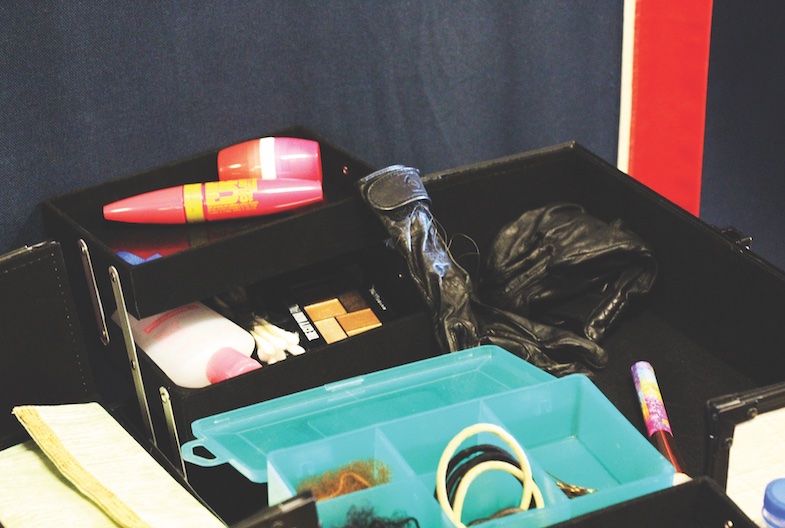 Your caboodle should hold everything from the makeup to hair accessories you will need on show day. // Photo by Lauren Gall
Your caboodle should hold everything from the makeup to hair accessories you will need on show day. // Photo by Lauren Gall
You’ve been taking lessons for a few months, or maybe a few years, and you’re finally ready to begin showing. For most exhibitors in the saddle seat world, that means an exciting entrance into the academy division.
Academy is a division created to provide a fun and safe way for children and adults alike to experience showing horses in an economical and supportive environment. The horses in academy showing are used in lesson programs, and academy judging focuses on the performance of the rider and not the quality or conformation of the horse. It is an excellent way to begin a show career without investing in a privately owned and professionally trained performance horse.
However, as first time exhibitors look forward to their first horse show, they often have more questions than answers, and feel like they are in a foreign world. Managing all of the pieces and parts that seem to be required as you step into this new experience can be overwhelming, but the good news is that it doesn’t have to be.
 Number magnets are a great investment and add a touch of class to your outfit. // Photo by Lauren GallIt is easy to think you have to obtain everything at once, but this is not the case at all. Consult your instructor for the specific expectations that they have within their program, and then start with the basics. Begin with the basic “caboodle” and slowly increase your supplies as you become more involved in showing. Do not break the bank to have every possible item that you see others have. You will find that there are always more experienced academy friends and family members who can help out in a pinch – and will. These folks are a wealth of knowledge, and will give you tips and tricks to make things easier. Remember, they were once in your shoes and someone helped them.
Number magnets are a great investment and add a touch of class to your outfit. // Photo by Lauren GallIt is easy to think you have to obtain everything at once, but this is not the case at all. Consult your instructor for the specific expectations that they have within their program, and then start with the basics. Begin with the basic “caboodle” and slowly increase your supplies as you become more involved in showing. Do not break the bank to have every possible item that you see others have. You will find that there are always more experienced academy friends and family members who can help out in a pinch – and will. These folks are a wealth of knowledge, and will give you tips and tricks to make things easier. Remember, they were once in your shoes and someone helped them.
One of the best perks of academy showing is the camaraderie that comes from early mornings, late nights, unpredictable weather and travel to exotic horse show locations! Academy teams are like no other athletic team. There is something so special about seeing a rider and their teammate – a 1200-pound animal with a brain and free will – perform like a seamless pair. Whether you or your rider spends a year in academy or a decade, whether this leads to owning a show horse or the decision to ride for pleasure alone, the show experience will teach lessons and provide experiences that will last a lifetime.
Academy Show Apparel
Other than actually going to a horse show, choosing your apparel is usually the most fun part of starting off in academy, as it provides the opportunity to express you or your rider’s individuality and personality.
Apparel choices range from bright and fun to more classic styles depending on your preference. It is always a good idea to consider consignment clothing, especially for a young rider, or someone new to showing. There are many excellent consignment shops that will ship items to try before purchase, and many of these shops will attend shows with a large clothing selection. The owners and staff of these shops are knowledgeable in fitting show clothing and in helping to find an outfit that will fit your budget and that will last.
Fitting show clothing is very specialized; the focus lies on the way it looks when you or the rider are on the horse, not how it looks when standing on the ground. For this reason it is not recommended that clothing be purchased “off the rack” or be tailored by someone without experience in this area. By purchasing academy apparel from consignment or from an equestrian apparel vendor, you will also be able to build in extra fabric to increase the longevity of an outfit by allowing for alterations. Many academy vests are also reversible, which allows for a nice variety. All shirts need to have holes in the collar to accommodate a tie bar.
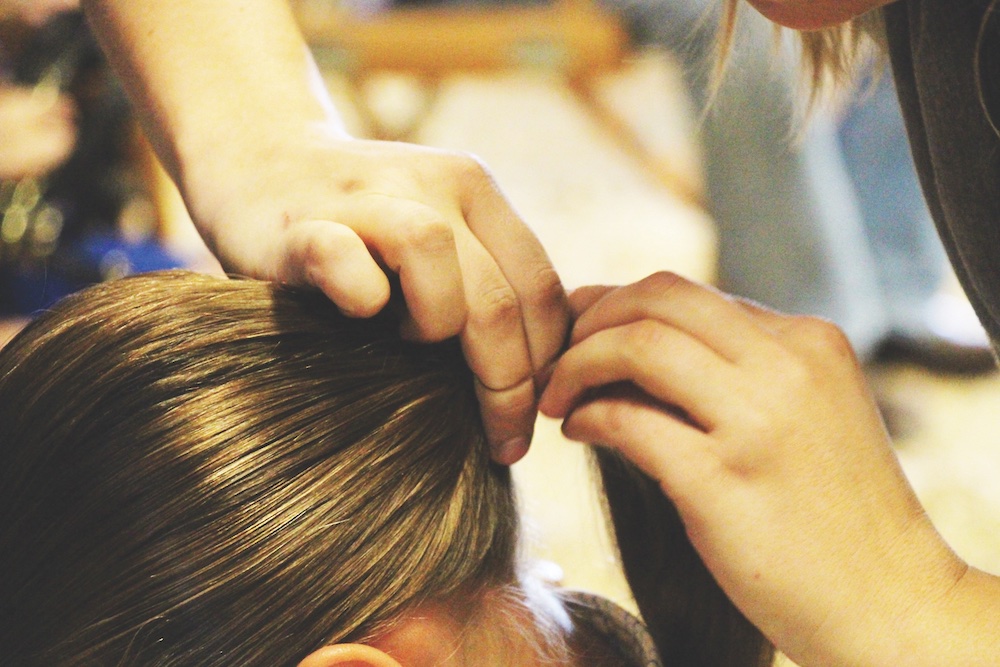 When making a bun you will need to start with your hair in a low pony tail. // Photo by Lauren GallWhen chosen well, a professionally made new or consignment outfit is a worthwhile investment in the rider’s show experience. See below for the essential components of a complete academy outfit.
When making a bun you will need to start with your hair in a low pony tail. // Photo by Lauren GallWhen chosen well, a professionally made new or consignment outfit is a worthwhile investment in the rider’s show experience. See below for the essential components of a complete academy outfit.
Helmet
Helmets are required at most shows for riders 10 and under, but nearly all shows strongly encourage helmets for all academy division riders. Wearing a safety helmet is critical to rider safety. Helmets can be black or custom painted to coordinate with the rider’s apparel – many local car dealerships will paint a helmet for a reasonable fee. Custom helmets are more common on younger riders with those over 10 opting for black, brown or navy to match the rider’s pants. Most academy school helmets are provided by Ovation or Troxel. For girls with hair that can be made into a bun, show helmets with an adjustable dial in the back should be avoided, as this helmet type will not accommodate a bun. It is generally a good idea to have dedicated show helmet, so as to avoid the wear and tear of lessons. Most girls in academy choose to wear a small bow (bun bow) or crystal barrette in the center of the bun as a final touch.
Vest and shirt
This is where the rider’s personality shines. Look for quality pieces and professional providers. Include your trainer and/or barn owner in the selection. The outfit you choose represents their business as well as you or your child.
Tie
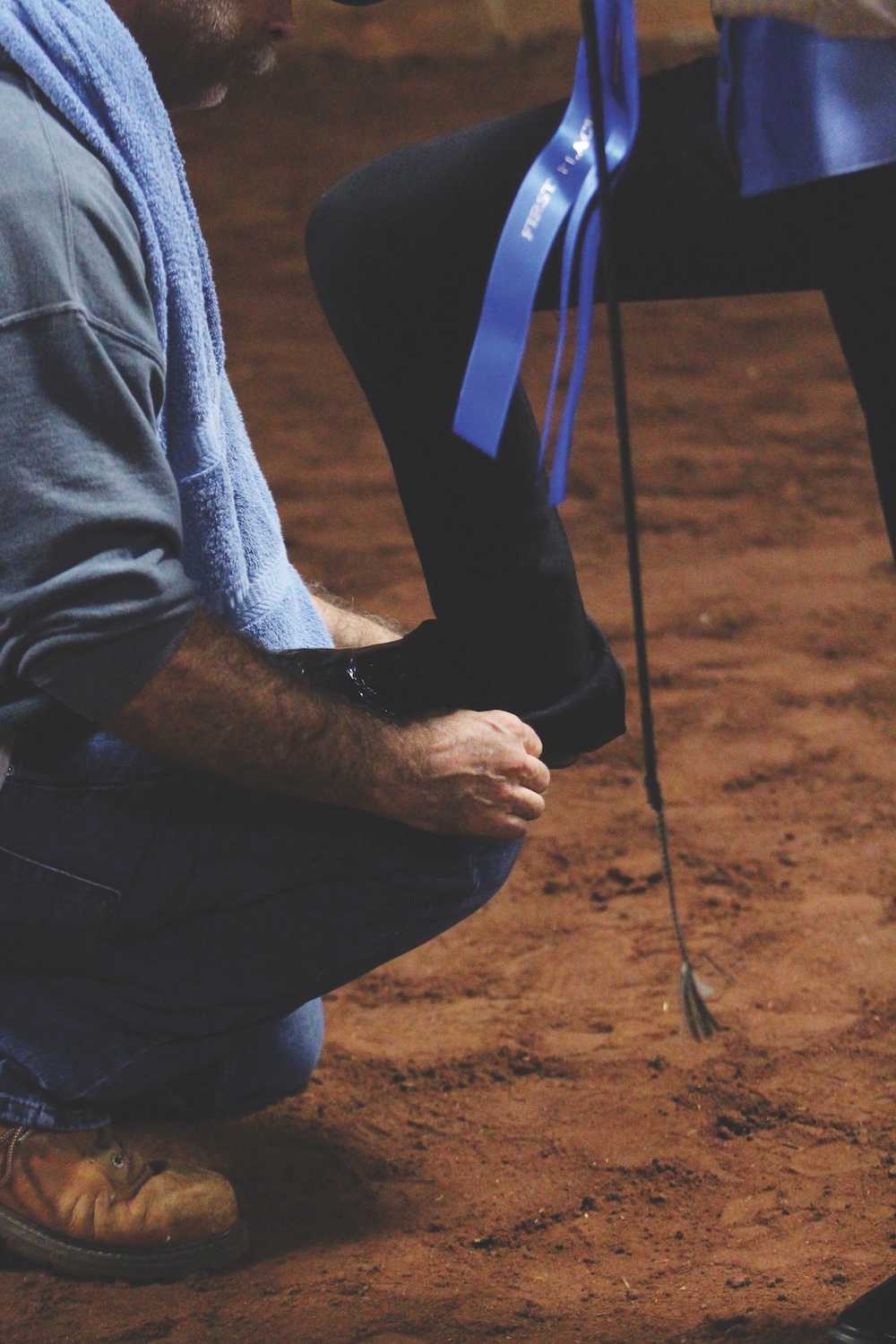 When not mounted remember to keep your jods rolled up so they stay clean. // Photo by Lauren GallTies can be purchased about anywhere and can often be altered to fit smaller riders. These are often the “pop of color” that pulls the academy outfit together. Women and girls wear standard dress ties; boys and men occasionally wear bow ties. Some riders have two or three ties that are different colors and patterns that complement the shirt and vest to add an affordable level of variety to academy apparel
When not mounted remember to keep your jods rolled up so they stay clean. // Photo by Lauren GallTies can be purchased about anywhere and can often be altered to fit smaller riders. These are often the “pop of color” that pulls the academy outfit together. Women and girls wear standard dress ties; boys and men occasionally wear bow ties. Some riders have two or three ties that are different colors and patterns that complement the shirt and vest to add an affordable level of variety to academy apparel
Jods
Jods can vary from “stock jods” in basic sizes and lengths to jods made to the rider’s specifications. These should be black, navy, or brown only to coordinate with the vest and shirt. Make sure that they cover the top of the boot or they will be too short on the horse. For academy shows they should be a “boot cut,” not a tight ankle “riding tight” or “schooler” pant – no spandex. They should have buttons (either one or two – it makes no difference) on the inside cuffs to attach underpasses or “tie downs.” These are elastic straps that attach on the inside of the jods and pass under the sole of the riding boot to keep pants from riding up when in the show ring.
Boots
Black or brown pull-on or zip-up paddock boots are recommended in the academy setting. They can be standard or patent leather. If possible, having a dedicated pair of boots to be worn just for shows will add to a polished look. Boots should always be clean and should match the rider’s show jods. It is common to tape around the top of the boot to prevent the back edge from forming a bump in the jods when the rider presses his or her heels down. It’s a small touch that adds to a beautifully appointed rider.
Gloves
Gloves should be black, brown or navy to match the pants. Leather or leather-like materials are best to help with grip. If the glove top is at the wrist, it is helpful to tape the top of the glove around the wrist with matching color electrical tape to keep the cuff of the shirt from catching on the glove edge. Similar to taping a rider’s boot tops, this lends to a clean, crisp appearance.

Bling
Many riders wear a pin on the left or right front of the vest to express their personal style. Common choices are horseshoes, horses, initials and four-leaf clovers. Keep in mind, small and conservative is best. The shirt collar should be closed with a tie bar, and small, stud-like earrings are recommended for a rider with pierced ears. Many vendors provide a “show set” that includes a tie bar, earrings, back magnets and even barrette to wear on the rider’s bun, all made with the same color gem pieces. These are available from many of the consignment vendors and other vendors at horse shows and online.
Final details
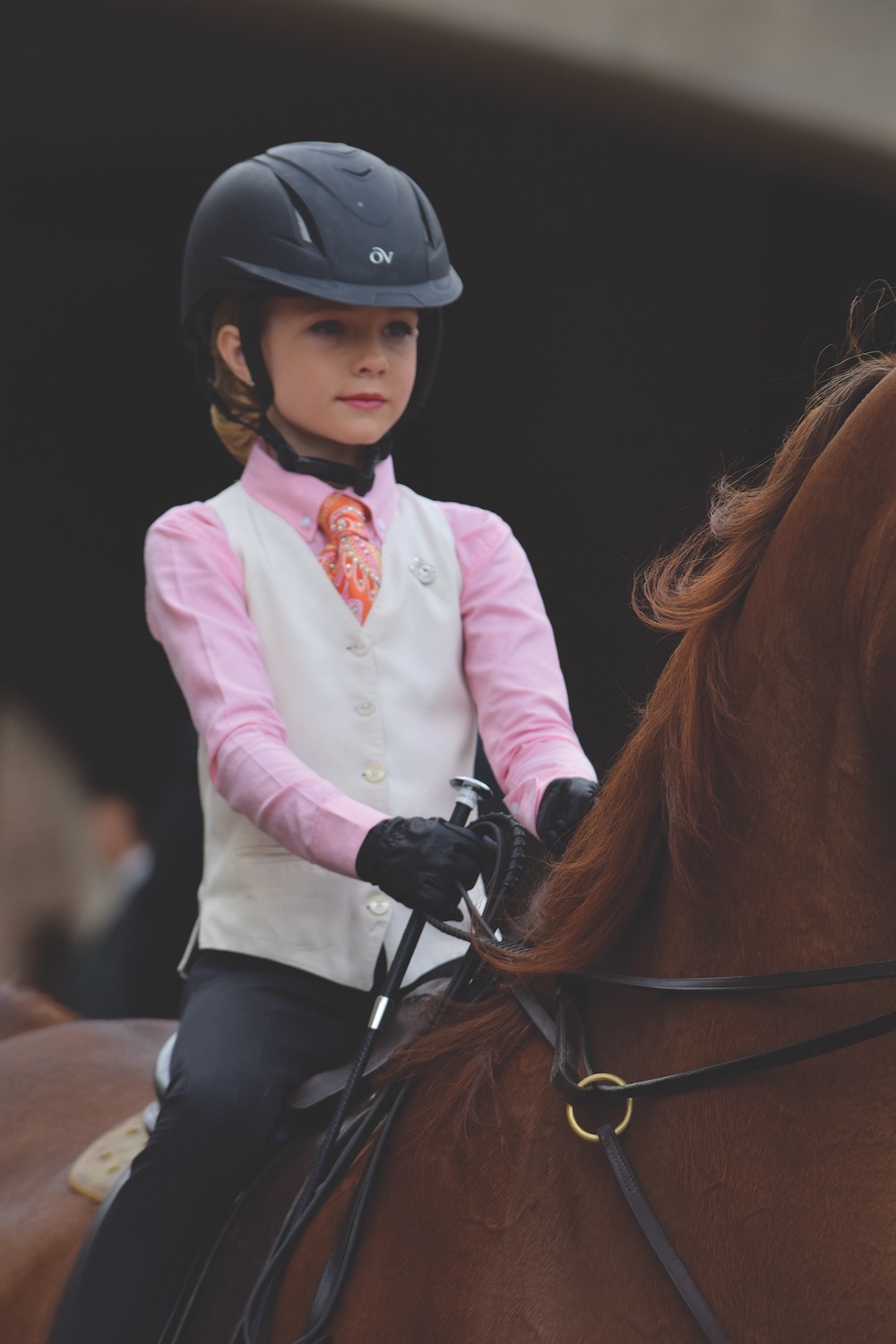 Remember that how you or your rider is turned out reflects on your barn as well. Strive to be as well put together as this young rider. // Photo by Allie LayosIt is a good idea to invest in a duffel bag and garment bag to store the rider’s show outfit and all accessories in. Rest assured there is no greater frustration than trying to get a rider ready when show clothes are in a disorganized mess. It creates stress for everyone, most importantly the rider.
Remember that how you or your rider is turned out reflects on your barn as well. Strive to be as well put together as this young rider. // Photo by Allie LayosIt is a good idea to invest in a duffel bag and garment bag to store the rider’s show outfit and all accessories in. Rest assured there is no greater frustration than trying to get a rider ready when show clothes are in a disorganized mess. It creates stress for everyone, most importantly the rider.
While this may seem like a lot of information to remember, you will be surrounded by seasoned people and your instructor/trainer, who will all be great resources for you and will be happy to help.
Sportsmanship
As with any competitive sport, the ability to display good sportsmanship is as important as athletic ability and skill. Academy horse show teams are teams. This is horse showing at the amateur level. Often members of the same barn will compete in the same classes. Remind your rider that they are competitors in the show ring, and friends on the ground. Intra-barn competition between academy riders can lead to strife and hurt feelings.
Parents should heed this warning as well. Everyone wants to a show, ride well and place well. It is important to remember that riding and showing horses is full of unpredictability and subjectivity. Going into a show expecting to win is seldom a good plan. The best riders show for the love of it. Winning the ribbon is fun and exciting but there will be many rides that seem to be perfect that are not rewarded, and many rides that may not seem to be great that take the victory pass. A great quote relating to this subject is “You either win or you learn.”
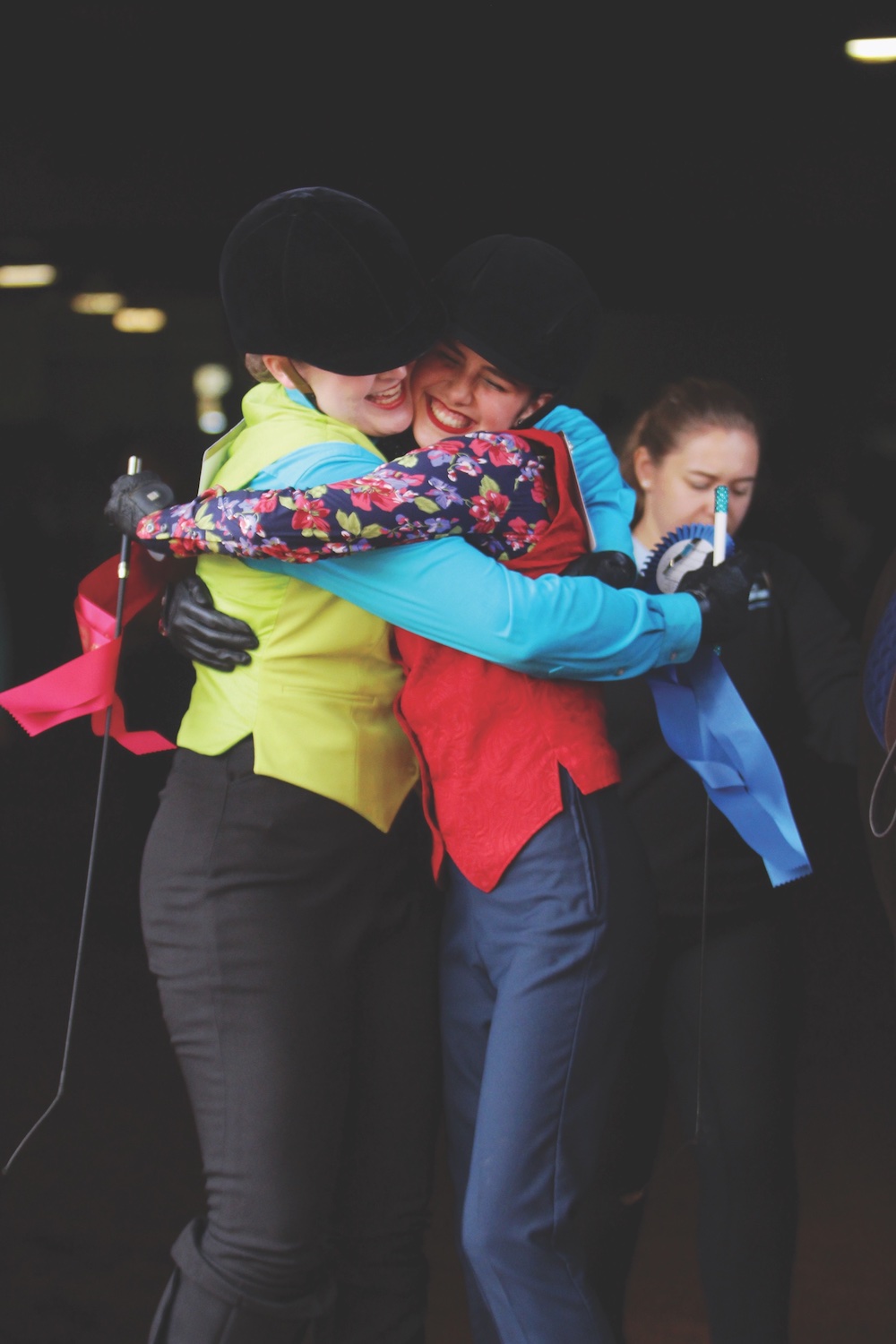 Sportsmanship is of upmost importance. Riders can be competitors inside the ring and still be friends outside of it. // Photo by Lauren GallWhen your rider does well, act graciously and encourage the same in the rider. When the rider has a difficult ride or has a ride that is not scored, be even MORE gracious. It is very tempting to make excuses or criticize the judge or other riders. Doing so is just evidence of poor sportsmanship. Remind yourself and your rider that you are doing this for the fun, camaraderie and experience that comes for the academy showing experience. If that is not why you or your rider are entering this crazy world, then you can save a whole lot of money and time by ordering a box of 100 blue ribbons online for less than $50.00. The best barns celebrate each rider’s desire to show horses with very little focus on the ribbon awarded. It’s what makes this a very special sport.
Sportsmanship is of upmost importance. Riders can be competitors inside the ring and still be friends outside of it. // Photo by Lauren GallWhen your rider does well, act graciously and encourage the same in the rider. When the rider has a difficult ride or has a ride that is not scored, be even MORE gracious. It is very tempting to make excuses or criticize the judge or other riders. Doing so is just evidence of poor sportsmanship. Remind yourself and your rider that you are doing this for the fun, camaraderie and experience that comes for the academy showing experience. If that is not why you or your rider are entering this crazy world, then you can save a whole lot of money and time by ordering a box of 100 blue ribbons online for less than $50.00. The best barns celebrate each rider’s desire to show horses with very little focus on the ribbon awarded. It’s what makes this a very special sport.
The Mama Box
“Time to sit in the Mama Box” is a reminder that a well-known academy barn owner gives to her academy parents when they are becoming a distraction to their rider at a show. This is a place in the stands where members of each barn congregate away from the warm-up ring. While horse shows are full-on family and friends events, it is important to remember that they are also an extension of the rider’s riding lessons. Teaching show ring presence and performance can only occur in the show ring. For this very reason it is important to know and respect the instructor’s guidelines and instructions at a show.
Arrive when you are asked to arrive and have your rider ready when asked. Do not demand individual attention on show grounds. This is not the place to discuss lesson schedules, horse/rider assignments or other non-emergent issues. Be willing to help other riders, parents, and most importantly, your instructor. As a “new to showing” parent, you may think that you have no help to offer. This is not true. Ask how you can help out, be open to learning and you’ll be a pro in no time.
Don’t compare your rider to any other rider. Do not let the rider do this either. Riders learn on their own continuum, with riders beginning lessons and entering the show ring at different ages. Be prepared for the surge of emotion that accompanies seeing your rider enter the show ring (it will always be emotional no matter how long they show). Spend time with fellow Barn Family members … chances are you will be spending a lot of time together! Finally, when your rider is dressed and ready, turn them over to their instructor to allow them to mentally and physically enter the ring. Then, for goodness sakes, go sit in the Mama Box!



